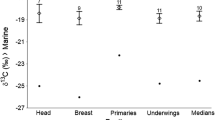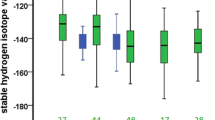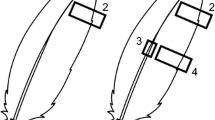Abstract
Tools to study seasonal changes in animal diets are needed to address a wide range of ecological questions. This is especially true of migratory animals that experience distinct environments where diets may be substantially different. However, tracking diets of individuals that move vast distances has proven difficult. Compound-specific isotope analysis has emerged as a valuable tool to study diets but has been little used to study dietary changes of migratory animals. Using this technique, we quantify seasonal variation in the annual diet of a migratory songbird (gray-cheeked thrush, Catharus minimus) and test the hypothesis that migrants change their diet in response to the energetic requirements of different periods of the annual cycle. By measuring δ13C and δ15N values of amino acids from feathers grown on the breeding grounds, blood formed during migration and claw grown on the wintering grounds, we found that migration is associated with greater consumption of fruit, compared to the breeding or wintering periods. This was confirmed by the lower trophic position of blood compared to feather and claw, by a decrease in the δ15N value of the source amino acid phenylalanine in blood as a function of days of stopover, and by the positive correlation between δ15N and δ13C values of phenylalanine in blood, and not in feather or claw. This study illustrates how isotopic analysis of amino acids can contribute to understand food webs, seasonal dietary changes and metabolic routing of nutrients in migratory animals.




Similar content being viewed by others
References
Acevedo Seaman D, Guglielmo CG, Elner RW, Williams TD (2006) Landscape-scale physiology: site differences in refueling rates indicated by plasma metabolite analysis in free-living migratory sandpipers. Auk 123:563–574
Aharon-Rotman Y, Gosbell K, Minton C, Klaassen M (2016) Why fly the extra mile? Latitudinal trend in migratory fuel deposition rate as driver of trans-equatorial long-distance migration. Ecol Evol 6:6616–6624
Arthur KE, Kelez S, Larsen T et al (2014) Tracing the biosynthetic source of essential amino acids in marine turtles using delta13C fingerprints. Ecology 95:1285–1293
Bairlein F (1990) Nutrition and food selection in migratory birds. In: Gwinner E (ed) Bird migration. Springer, Berlin, pp 198–213
Bairlein F (2002) How to get fat: nutritional mechanisms of seasonal fat accumulation in migratory songbirds. Naturwissenschaften 89:1–10
Bairlein F, Gwinner E (1994) Nutritional mechanisms and temporal control of migratory energy accumulation in birds. Annu Rev Nutr 14:187–215
Bairlein F, Eikenaar C, Schmaljohann H (2015) Routes to genes: unravelling the control of avian migration—an integrated approach using Northern Wheatear Oenanthe oenanthe as model organism. J Ornithol 156(1):3–14
Bayly NJ, Gómez C, Hobson KA (2013) Energy reserves stored by migrating gray-cheeked thrushes (Catharus minimus) at a spring stopover site in northern Colombia, are sufficient for a long-distance flight to North America. Ibis 155:271–283
Bearhop S, Adams CE, Waldron S et al (2004) Determining trophic niche width: a novel approach using stable isotope analysis. J Anim Ecol 73:1007–1012
BirdLife International (2017) Species factsheet: Catharus minimus. Downloaded from http://www.birdlife.org on 31/01/2017. http://datazone.birdlife.org/species/factsheet/grey-cheeked-thrush-catharus-minimus/distribution. Accessed 31 Jan 2017
Blake JG, Loiselle BA (1992) Fruits in the diets of Neotropical migrant birds in Costa Rica. Biotropica 24:200–210
Blanquart F, Gandon S (2014) On the evolution of migration in heterogeneous environments. Evolution 68:1617–1628
Boecklen WJ, Yarnes CT, Cook BA, James AC (2011) On the use of stable isotopes in trophic ecology. Annu Rev Ecol Evol Syst 42:411–440
Boone AT, Rodewald PG, DeGroote LW (2010) Neotropical winter habitat of the Magnolia Warbler: effects on molt, energetic condition, migration timing, and hematozoan infection during spring migration. Condor 112:115–122
Bowen GJ (2010) Isoscapes: spatial pattern in isotopic biogeochemistry. Annu Rev Earth Planet Sci 38:161–187
Bowes RE, Thorp JH (2015) Consequences of employing amino acid vs. bulk-tissue, stable isotope analysis: a laboratory trophic position experiment. Ecosphere 6:14
Bradley CJ, Wallsgrove NJ, Choy CA et al (2015) Trophic position estimates of marine teleosts using amino acid compound specific isotopic analysis. Limnol Oceanogr Methods 13:476–493
Chabot A, Hobson K, Van Wilgenburg SL et al (2012) Advances in linking wintering migrant birds to their breeding-ground origins using combined analyses of genetic and stable isotope markers. PLoS ONE 7:e43627
Chikaraishi Y, Ogawa NO, Kashiyama Y et al (2009) Determination of aquatic food-web structure based on compound-specific nitrogen isotopic composition of amino acids. Limnol Oceanogr Methods 7:740–750
Chikaraishi Y, Ogawa N, Ohkouchi N (2010) Further evaluation of the trophic level estimation based on nitrogen isotopic composition of amino acids. In: Ohkouchi N, Tayasu I, Koba K (eds) Earth, life, isotopes. Kyoto University Press, Kyoto, pp 37–51
Fernandes R, Millard AR, Brabec M et al (2014) Food reconstruction using isotopic transferred signals (FRUITS): a Bayesian model for diet reconstruction. PLoS ONE 9:1–9
Fry B (2006) Stable isotope ecology, vol 521. Springer, New York
Fuller BT, Petzke KJ (2017) The dietary protein paradox and threonine 15 N-depletion: pyridoxal-5′-phosphate enzyme activity as a mechanism for the δ 15 N trophic level effect. Rapid Commun Mass Spectrom 31:705–718
Gerson AR, Guglielmo CG (2011) Flight at low ambient humidity increases protein catabolism in migratory birds. Science 333:1434–1436
Gómez C, Bayly NJ, Norris DR et al (2017) Fuel loads acquired at a stopover site influence the pace of intercontinental migration in a boreal songbird. Sci Rep 7:3405
Gunnarsson TG, Gill JA, Newton J et al (2005) Seasonal matching of habitat quality and fitness in a migratory bird. P Roy Soc Lond B Biol 272:2319–2323
Hahn S, Dimitrov D, Rehse S et al (2014) Avian claw morphometry and growth determine the temporal pattern of archived stable isotopes. J Avian Biol 45:202–207
Hardesty JL, Fraser KC (2010) Using deuterium to examine altitudinal migration by Andean birds. J Field Ornithol 81:83–91
Hebert CE, Popp BN, Fernie KJ et al (2016) Amino acid-specific stable nitrogen isotope values in avian tissues: insights from captive American Kestrels and wild Herring Gulls. Environ Sci Technol. https://doi.org/10.1021/acs.est.6b04407
Hobson KA (2005) Flying Fingerprints. In: Greenberg R, Marra PP (eds) Birds of two worlds. The ecology and evolution of migration. Johns Hopkins University Press, Baltimore, pp 235–247
Hobson KA, Bairlein F (2003) Isotopic fractionation and turnover in captive Garden Warblers (Sylvia borin): implications for delineating dietary and migratory associations in wild passerines. Can J Zool 81:1630–1635
Hobson KA, Clark RG (1992) Assessing avian diets using stable isotopes II: factors influencing diet-tissue fractionation. Condor 94:189–197
Hobson KA, Wassenaar LI, Milá B et al (2003) Stable isotopes as indicators of altitudinal distributions and movements in an Ecuadorean hummingbird community. Oecologia 136:302–308
Hobson KA, Bowen GJ, Wassenaar LI et al (2004) Using stable hydrogen and oxygen isotope measurements of feathers to infer geographical origins of migrating European birds. Oecologia 141:477–488
Hobson KA, Slater GL, Lank DB et al (2013) Agricultural lands subsidize winter diet of the Dunlin at two major estuaries. Condor 115:515–524
Hutto RL (1990) Studies of foraging behavior: central to understanding the ecological consequences of variation in food abundance. Stud Avian Biol 13:389–390
Jarman CL, Larsen T, Hunt T et al (2017) Diet of the prehistoric population of Rapa Nui (Easter Island, Chile) shows environmental adaptation and resilience. Am J Phys Anthropol 164:343–361
Larsen T, Taylor DL, Leigh MB, O’Brien DM (2009) Stable isotope fingerprinting: a novel method for identifying plant, fungal, or bacterial origins of amino acids. Ecology 90:3526–3535
Larsen T, Ventura M, Andersen N et al (2013) Tracing carbon sources through aquatic and terrestrial food webs using amino acid stable isotope fingerprinting. PLoS ONE 8:e73441
Larsen T, Ventura M, Maraldo K et al (2016) The dominant detritus-feeding invertebrate in arctic peat soils derives its essential amino acids from gut symbionts. J Anim Ecol 85:1275–1285
Layman CA, Araujo MS, Boucek R et al (2012) Applying stable isotopes to examine food-web structure: an overview of analytical tools. Biol Rev 87:545–562
Levey DJ, Martínez del Rio C (2001) It takes guts (and more) to eat fruit: lessons from avian nutritional ecology. Auk 118:819–831
Levey DJ, Stiles FG (1992) Evolutionary precursors of long-distance migration: resource availability and movement patterns in Neotropical landbirds. Am Nat 140:447–476
Lindström Å, Piersma T (1993) Mass changes in migrating birds evidence for fat and protein storage re-examined. Ibis 135:70–78
Liu H, Luo L, Cai D (2018) Stable carbon isotopic analysis of AAs in a simplified food chain consisting of Chlorella spp., Calanus sinicus and Engraulis japonicus. Can J Zool 96:23–30
Lorrain A, Graham B, Ménard F et al (2009) Nitrogen and carbon isotope values of individual amino acids: a tool to study foraging ecology of penguins in the Southern Ocean. Mar Ecol Prog Ser 391:293–306
Lowther PE, Rimmer CC, Kessel B et al (2001) Gray-cheeked thrush (Catharus minimus). In: Birds of North America. https://birdsna.org/Species-Account/bna/species/gycthr. Accessed 8 Feb 2013
Madigan DJ, Baumann Z, Carlisle AB et al (2014) Reconstructing transoceanic migration patterns of Pacific bluefin tuna using a chemical tracer toolbox. Ecology 95:1674–1683
Martin TE (1987) Food as a limit on breeding birds: a life history perspective. Annu Rev Ecol Syst 18:453–487
McClelland JW, Montoya JP (2002) Trophic relationships and the nitrogen isotopic composition of amino acids in plankton. Ecology 83:2173–2180
McKinnon E, Kyser KT, Stutchbury BJM (2017) Does the proportion of arthropods versus fruit in the diet influence overwintering condition of an omnivorous songbird? J Field Ornithol 88:65–79
McMahon KW, Fogel ML, Elsdon TS, Thorrold SR (2010) Carbon isotope fractionation of amino acids in fish muscle reflects biosynthesis and isotopic routing from dietary protein. J Anim Ecol 79:1132–1141
McMahon KW, Polito MJ, Abel S et al (2015) Carbon and nitrogen isotope fractionation of amino acids in an avian marine predator, the gentoo penguin (Pygoscelis papua). Ecol Evol 5:1278–1290
McWilliams SR, Guglielmo C, Pierce B, Klaassen M (2004) Flying, fasting, and feeding in birds during migration: a nutritional and physiological ecology perspective. J Avian Biol 35:377–393
Newsome SD, Fogel ML, Kelly L, Del Rio CM (2011) Contributions of direct incorporation from diet and microbial amino acids to protein synthesis in Nile tilapia. Funct Ecol 25:1051–1062
Newsome SD, Yeakel JD, Wheatley PV, Tinker MT (2012) Tools for quantifying isotopic niche space and dietary variation at the individual and population level. J Mammal 93:329–341
Newsome SD, Wolf N, Peters J, Fogel ML (2014) Amino acid δ13C analysis shows flexibility in the routing of dietary protein and lipids to the tissue of an omnivore. Integr Comp Biol 54:890–902
Newton I (2004) Population limitation in migrants. Ibis 146:197–226
Nielsen JM, Popp BN, Winder M (2015) Meta-analysis of amino acid stable nitrogen isotope ratios for estimating trophic position in marine organisms. Oecologia 178:631–642
Nisbet ICT, Drury WH, Baird J (1963) Weight loss during migration part I: deposition and consumption of fat by the Blackpoll Warbler. Bird XXXIV:107–138
O’Brien DM (2015) Stable isotope ratios as biomarkers of diet for health research. Annu Rev Nutr 35:565–594
O’Connell TC (2017) “Trophic” and “source” amino acids in trophic estimation: a likely metabolic explanation. Oecologia 184:317–326
Podlesak DW, McWilliams SR (2006) Metabolic routing of dietary nutrients in birds: effects of diet quality and macronutrient composition revealed using stable isotopes. Physiol Biochem Zool 79:534–549
Podlesak DW, McWilliams SR, Hatch KA (2005) Stable isotopes in breath, blood, feces and feathers can indicate intra-individual changes in the diet of migratory songbirds. Oecologia 142:501–510
Popp BN, Graham BS, Olson RJ et al (2007) Insight into the trophic ecology of yellowfin tuna, Thunnus albacares, from compound-specific nitrogen isotope analysis of proteinaceous amino acids. In: Dawson TE, Siegwolf RTW (eds) Isotopes as indicators of ecological change. Elsevier Inc., Amsterdam, pp 173–190
Post DM (2002) Using stable isotopes to estimate trophic position: models, methods, and assumptions. Ecology 83:703–718
Poulin B, Lefebvre G, McNeil R (1992) Tropical avian phenology in relation to abundance and exploitation of food resources. Ecology 73:2295–2309
Powell RL, Still CJ (2009) Biogeography of C3 and C4 vegetation in South America. An. XIV Simp. Bras. Sensoramento Remoto, pp 2935–2942
Price ER (2010) Dietary lipid composition and avian migratory flight performance: development of a theoretical framework for avian fat storage. Comp Biochem Physiol Part A 157:297–309
R Development Core Team (2017) R: a language and environment for statistical computing. R Foundation for Statistical Computing, Vienna, Austria. http://www.R-project.org. ISBN: 3-900051-07-0
Rosenberg KV (1990) Dead-leaf foraging specialization in tropical forest birds: measuring resource availability and use. Stud Avian Biol 13:360–368
Rosenberg KV, Cooper RJ (1990) Approaches to avian diet analysis. Stud Avian Biol 13:80–90
Rubenstein DR, Hobson KA (2004) From birds to butterflies: animal movement patterns and stable isotopes. Trends Ecol Evol 19:256–263
Ruegg KC, Anderson EC, Harrigan RJ, Paxton KL, Kelly JF, Moore F, Smith TB (2017) Genetic assignment with isotopes and habitat suitability (GAIAH), a migratory bird case study. Methods Ecol Evol 8(10):1241–1252
Schaefer HM, Schmidt V, Bairlein F (2003) Discrimination abilities for nutrients: which difference matters for choosy birds and why? Anim Behav 65:531–541
Schmaljohann H, Eikenaar C (2017) How do energy stores and changes in these affect departure decisions by migratory birds? A critical view on stopover ecology studies and some future perspectives. J Comp Physiol A 203:411–429
Smith S, McWilliams SR (2010) Patterns of fuel use and storage in migrating passerines in relation to fruit resources at autumn stopover sites. Auk 127:108–118
Smith SB, McPherson KH, Backer JM et al (2007) Fruit quality and consumption by songbirds during autumn migration. Wilson J Ornithol 119:419–428
Steffan SA, Chikaraishi Y, Horton DR et al (2013) Trophic hierarchies illuminated via amino acid isotopic analysis. PLoS ONE 8:21–23
Still CJ, Berry JA, Collatz GJ, DeFries RS (2003) Global distribution of C3 and C4 vegetation: carbon cycle implications. Glob Biogeochem Cycles 17:1006
Taylor CM, Stutchbury BJM (2016) Effects of breeding versus winter habitat loss and fragmentation on the population dynamics of a migratory songbird. Ecol Appl 26:424–437
Thompson DR, Phillips RA, Stewart FM, Waldron S (2000) Low δ13C signatures in pelagic seabirds: lipid ingestion as a potential source of 13C-depleted carbon in the Procellariiformes. Mar Ecol Prog Ser 208:265–271
Ungvari-Martin J, Heckscher CM, Hobson KA (2016) Inter-annual site fidelity and breeding origins of gray-cheeked thrushes in white sand forests of the Peruvian Amazon. J Field Ornithol 87:55–64
Venables WN, Ripley BD (2002) Modern applied statistics with S, 4th edn. Springer, New York
Voigt CC, Rex K, Michener RH, Speakman JR (2008) Nutrient routing in omnivorous animals tracked by stable carbon isotopes in tissue and exhaled breath. Oecologia 157:31–40
Acknowledgements
We thank Natalie Wallsgrove for her training and help in the lab, and Nick Bayly, Jeyson Sanabria, Laura Céspedes and Paulo Pulgarín for their support in the field. We also thank Nathan Cooper, Seth Newsome and two anonymous reviewers for their comments, which helped us improve previous versions of this manuscript. All applicable institutional and/or national guidelines for the care and use of animals were followed. This is SOEST Contribution number 10332.
Funding
This study was funded by a ‘research in residence’ award from the University of Utah (NSF award #1137336 for inter-university training in continental-scale ecology), by Colciencias (‘Ciencias Básicas’ Grant no. 658), by the Universidad de Los Andes (Proyecto Semilla) and by a Memorial fund Grant from the Eastern Bird Banding Association. TL was supported by the DFG funded Cluster of Excellence 80 “The Future Ocean”.
Author information
Authors and Affiliations
Contributions
CG, BP, KAH and CDC designed the study and CG collected the samples. CG, TL and KH ran laboratory analyses. CG analyzed the data, led the writing of the manuscript and all authors contributed critically to the drafts and gave approval for publication.
Corresponding author
Additional information
Communicated by Seth Newsome.
We show for the first time how isotopic analysis of amino acids from feathers, blood and claws, obtained at a single location may be used to infer the annual changes in diet of a migratory songbird.
Electronic supplementary material
Below is the link to the electronic supplementary material.
Rights and permissions
About this article
Cite this article
Gómez, C., Larsen, T., Popp, B. et al. Assessing seasonal changes in animal diets with stable-isotope analysis of amino acids: a migratory boreal songbird switches diet over its annual cycle. Oecologia 187, 1–13 (2018). https://doi.org/10.1007/s00442-018-4113-7
Received:
Accepted:
Published:
Issue Date:
DOI: https://doi.org/10.1007/s00442-018-4113-7




